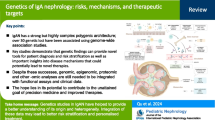Abstract
Not all patients with hyperuricemia will develop acute gouty arthritis, indicating that other initiating factors need to be considered. The P2X7 receptor is an adenosine triphosphate-gated nonselective cation channel that has also been suggested to be a proinflammatory receptor. In the immune system, the P2X7 receptor is involved in the processing and release of various proinflammatory cytokines, including interleukin-1β (IL-1β), IL-18 and tumor necrosis factor-α (TNF-α). IL-1β is a central cytokine in the initiation of the acute inflammatory response, which plays a key role in the pathogenesis of gout and the pathology of acute gouty arthritis. This review will explore single-nucleotide polymorphisms in the P2X7R gene [including rs1718119 (Ala348Thr), rs208294 (His155Tyr), rs3751143 (Glu496Ala), rs28360457 (Arg307Gln) and rs2230911 (Thr357Ser)] and their correlation with the incidence of gout. We conclude that P2X7R gene polymorphisms impact the secretion of IL-1β and thus play a vital role in the pathogenesis of gout.
Similar content being viewed by others
References
Robinson PC, Horsburgh S (2014) Gout: joints and beyond, epidemiology, clinical features, treatment and co-morbidities. Maturitas 78(4):245–251
Tao JH, Zhang Y, Li XP (2013) P2X7R: a potential key regulator of acute gouty arthritis. Semin Arthritis Rheum 43(3):376–380
Ferrari D, Pizzirani C, Adinolfi E et al (2006) The P2X7 receptor: a key player in IL-1 processing and release. J Immunol 176(7):3877–3883
Kingsbury SR, Conaghan PG, McDermott MF (2011) The role of the NLRP3 inflammasome in gout. J Inflamm Res 4:39–49
Steiger S, Harper JL (2014) Mechanisms of spontaneous resolution of acute gouty inflammation. Curr Rheumatol Rep 16(1):392
Van den Berg WB (2000) Arguments for interleukin 1 as a target in chronic arthritis. Ann Rheum Dis 59(Suppl 1):i81–i84
Rock KL, Latz E, Ontiveros F et al (2010) The sterile inflammatory response. Annu Rev Immunol 28:321–342
Rock KL, Kataoka H, Lai JJ (2013) Uric acid as a danger signal in gout and its comorbidities. Nat Rev Rheumatol 9(1):13–23
Pope RM, Tschopp J (2007) The role of interleukin-1 and the inflammasome in gout: implications for therapy. Arthritis Rheum 56(10):3183–3188
Martinon F (2010) Mechanisms of uric acid crystal-mediated autoinflammation. Immunol Rev 233(1):218–232
Terkeltaub RA, Schumacher HR, Carter JD et al (2013) Rilonacept in the treatment of acute gouty arthritis: a randomized, controlled clinical trial using indomethacin as the active comparator. Arthritis Res Ther 15(1):R25
Schlesinger N, Alten RE, Bardin T et al (2012) Canakinumab for acute gouty arthritis in patients with limited treatment options: results from two randomised, multicentre, active-controlled, double-blind trials and their initial extensions. Ann Rheum Dis 71(11):1839–1848
Jarvis MF, Khakh BS (2009) ATP-gated P2X cation-channels. Neuropharmacology 56(1):208–215
Chataigneau T, Lemoine D, Grutter T (2013) Exploring the ATP-binding site of P2X receptors. Front Cell Neurosci 7:273
Rumney RM, Wang N, Agrawal A et al (2012) Purinergic signalling in bone. Front Endocrinol (Lausanne) 3:116
Gever JR, Cockayne DA, Dillon MP et al (2006) Pharmacology of P2X channels. Pflugers Arch 452(5):513–527
Trautmann A (2009) Extracellular ATP in the immune system: more than just a “danger signal”. Sci Signal 2(56):pe6
Eleftheriadis T, Pissas G, Karioti A et al (2013) Uric acid induces caspase-1 activation, IL-1β secretion and P2X7 receptor dependent proliferation in primary human lymphocytes. Hippokratia 17(2):141–145
Alves LA, Bezerra RJ, Faria RX et al (2013) Physiological roles and potential therapeutic applications of the P2X7 receptor in inflammation and pain. Molecules 18(9):10953–10972
Kvist TM, Schwarz P, Jørgensen NR (2014) The P2X7 receptor: a key player in immune-mediated bone loss? Sci World J 2014:954530. doi:10.1155/2014/954530
Lenertz LY, Gavala ML, Zhu Y et al (2011) Transcriptional control mechanisms associated with the nucleotide receptor P2X7, a critical regulator of immunologic, osteogenic, and neurologic functions. Immunol Res 50(1):22–38
Andrei C, Margiocco P, Poggi A et al (2004) Phospholipases C and A2 control lysosome-mediated IL-1 beta secretion: implications for inflammatory processes. Proc Natl Acad Sci USA 101(26):9745–9750
Skaper SD (2011) Ion channels on microglia: therapeutic targets for neuroprotection. CNS Neurol Disord Drug Targets 10(1):44–56
Stokes L, Fuller SJ, Sluyter R et al (2010) Two haplotypes of the P2X(7) receptor containing the Ala-348 to Thr polymorphism exhibit a gain-of-function effect and enhanced interleukin-1beta secretion. FASEB J 24(8):2916–2927
Cabrini G, Falzoni S, Forchap SL et al (2005) A His-155 to Tyr polymorphism confers gain-of-function to the human P2X7 receptor of human leukemic lymphocytes. J Immunol 175(1):82–89
Gu BJ, Zhang W, Worthington RA et al (2001) A Glu-496 to Ala polymorphism leads to loss of function of the human P2X7 receptor. J Biol Chem 276(14):11135–11142
Wesselius A, Bours MJ, Arts IC et al (2012) The P2X(7) loss-of-function Glu496Ala polymorphism affects ex vivo cytokine release and protects against the cytotoxic effects of high ATP-levels. BMC Immunol 13:64
Shemon AN, Sluyter R, Fernando SL et al (2006) A Thr357 to Ser polymorphism in homozygous and compound heterozygous subjects causes absent or reduced P2X7 function and impairs ATP-induced mycobacterial killing by macrophages. J Biol Chem 281(4):2079–2086
Gu BJ, Sluyter R, Skarratt KK et al (2004) An Arg307 to Gln polymorphism within the ATP-binding site causes loss of function of the human P2X7 receptor. J Biol Chem 279(30):31287–31295
Roger S, Mei ZZ, Baldwin JM et al (2010) Single nucleotide polymorphisms that were identified in affective mood disorders affect ATP-activated P2X7 receptor functions. J Psychiatr Res 44(6):347–355
Amaral FA, Costa VV, Tavares LD et al (2012) NLRP3 inflammasome-mediated neutrophil recruitment and hypernociception depend on leukotriene B(4) in a murine model of gout. Arthritis Rheum 64(2):474–484
Portales-Cervantes L, Niño-Moreno P, Doníz-Padilla L et al (2010) Expression and function of the P2X(7) purinergic receptor in patients with systemic lupus erythematosus and rheumatoid arthritis. Hum Immunol 71(8):818–825
Sorge RE, Trang T, Dorfman R et al (2012) Genetically determined P2X7 receptor pore formation regulates variability in chronic pain sensitivity. Nat Med 18(4):595–599
Author information
Authors and Affiliations
Corresponding author
Rights and permissions
About this article
Cite this article
Gong, Qy., Chen, Y. Correlation between P2X7 receptor gene polymorphisms and gout. Rheumatol Int 35, 1307–1310 (2015). https://doi.org/10.1007/s00296-015-3258-5
Received:
Accepted:
Published:
Issue Date:
DOI: https://doi.org/10.1007/s00296-015-3258-5




